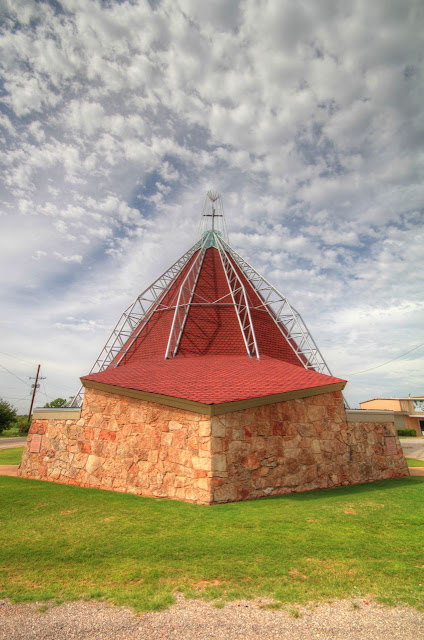edmund
Back in Oklahoma for bidness (water-water-water), I was able to steal some time in the mornings and evenings to see some stuff in the area (architecture is everywhere!). I was pleased to stop in to gawk at Bruce Goff's Hopewell Baptist Church (1950) in Edmund. The building's been in jeopardy due to asbestos insulation and a leaking roof, but, as you can see, it has a new top (thanks to the good folks at Jenco Roofing Company). Peeking in the windows, the place is gutted. Hopefully, the congregation will be able to fully restore (and use) the building. Both a threat (redevelopment?) and an opportunity (more parishioners?), greater Oklahoma City seems to be stretching in this direction. Would love to see the inside some time.
Note the blue glass in the "bell tower." The congregation built the church for $20,000.
ada
Ada is a quaint little town about 1.5 hours south-southeast out of Oklahoma City with a small college and a national environmental lab. The mayor is a water professor from the college! There's not much architecturally, but I stumbled across some good stuff during my morning and evening strolls about town.
Nice Deco post office and federal courthouse combo:
The fire station is also a lovely example of Art Deco:
McSwain Theatre is nicely restored and active:
Nice little International Style office building (with a water theme!):
I see (or at least I think I see) the influence of Goff in the area, such as at this Catholic Church:
The water tower one morning:
misc:
The Chickasaw Nation Pavilion by Fitzsimmons Architects
Robert S. Kerr family homestead.
sulphur
I took a look at a map to see what was in the area to maybe go gawk at one the evening, and lo and behold, a mere 30 minutes away, was Sulphur! I hooked up with an old college buddy who was also at the meeting, and we high-tailed it down to Sulphur right at the end of the conference, ties, suit coats, and all.
Back in the early 1900s, Sulphur, like many towns in the US that had saline springs or wells, was a resort destination where people could partake of the waters in the hopes of curing various ailments. Mineral water was a booming business up until the 1940s (or so) when the Feds required science to back the various medical claims as to the curative powers of the waters. Since there was no science, many resorts, no longer able to make ludicrous claims, faded away. The Vendome Well (and Sulphur in general) was no different.
Fortunately, the well is still there as part of the Chickasaw National Recreational Area (formerly the Platt National Park). There's a slight scent of sulphur when you approach the well; nothing offensive, but you know it's there. I sipped from a squirting water fountain at the well site; just a hint of salinity (the water is probably just north of fresh at 1,000 ppm of total dissolved solids). As you can see from the photos above, there used to be a pool next door with a water slide and diving board. These days, the flow heads down a small drainage to a nearby creek. According to my cohort, the flow has slowly declined over the years. The city shuts the well down at night these days to preserve pressure.
Nearby in the park are various springs, including Bromide Springs:
Sulphur-loving bacterial strands!
Which has also been around awhile:
Befitting a resort town, Sulphur has a large resort hotel called The Artesian.
Neat card showing the front and backside of the hotel. Note the flowing artesian well in the courtyard.
This card fuses the front and backside into one large building #falseadvertising
The hotel was still there and operational until a few years ago when it was razed to build the new Artesian:
On one hand, sad to have missed the original Artesian and for it to be gone; on the other hand, nice that the Artesian moves forward into a new century.
Next door is a modern visitor center by F+S+B:
greater ada
On the last day of the conference we went on an afternoon field trip (you know, the hottest time of the day) to learn about the aquifer in the area and Ada's water supply (and also the source of the wells and springs in Sulphur).
Ada's water supply comes from a spring issuing from the Arbuckle-Simpson Aquifer (my pal is an expert on the aquifer). It's an unusual aquifer in that it is thermally and chemically vertically homogenous (down to 3,000 feet deep). For those of you in the know, it's like the Edwards Aquifer turned on its head. The city's water supply pulls directly from the outfall of the spring which is then gravity fed to Ada. The spring is (sadly) covered with a concrete suspension cap, presumably to keep dead critters and naked frat boys from sullying the city's water supply.
Everything is painted green.
norman
On the way to the airport, I stopped in to potentially gawk at the remnants of one of Goff's greatest works, the logarithmically spiralling Bavinger House (1955):
Photo from Wikipedia in better days.
A windstorm damaged the structure and the owners, in an apparent tussle with preservationists, bulldozed the entire house earlier this year. That, my friends, is a serious bummer. You can't see anything from the street except a closed gate and two posts with video cameras.
photo from here
photo from here
Next to it is another Wilson-designed space, a garage/storm shelter/apartment:
oklahoma city
Probably not worthy enough to list OK City on its own, but here's a shot of the airport with what I would call a Goff-inspired design:




































































No comments:
Post a Comment